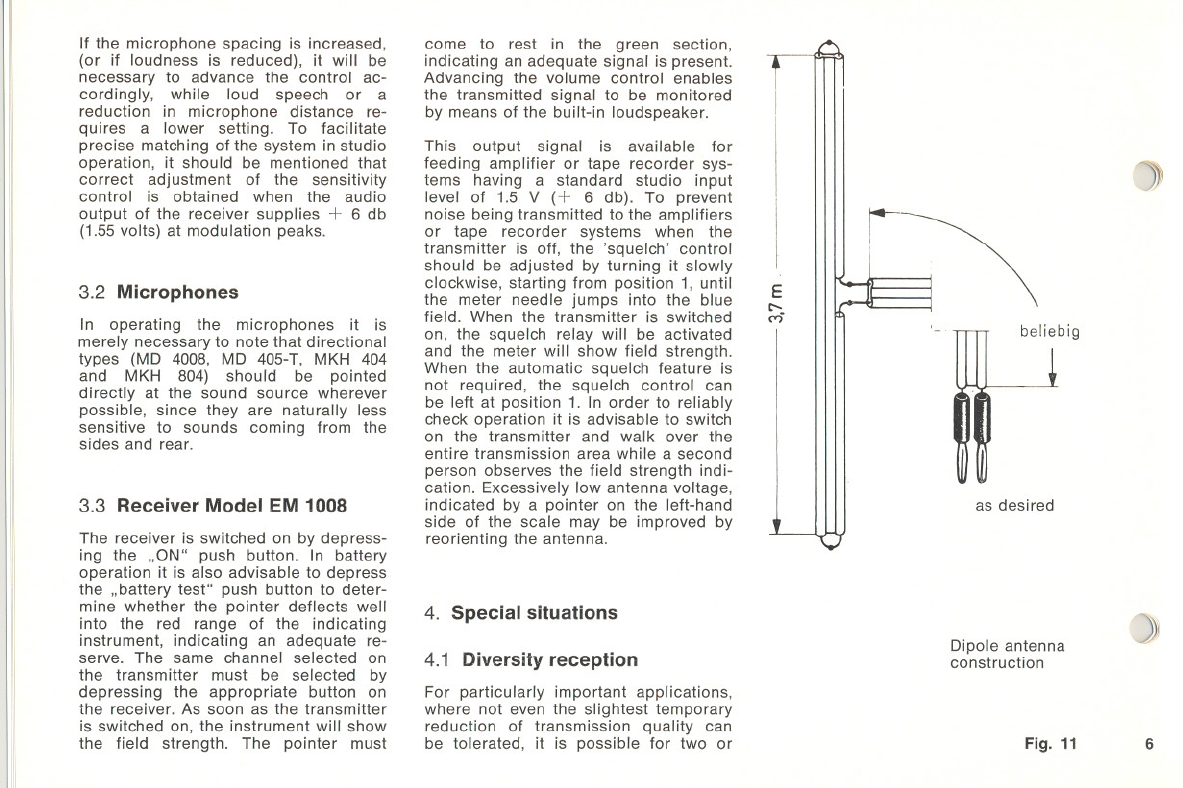
If the micraphone spacing is increased,
(or if loudness is reduced), It will be
necessary to advance the control ac-
cordingly, while loud speech or a
reduction in micraphone distance re-
quires a lower setting. To facilitate
precise matching of the system in studio
operation, it should be mentioned that
correct adjustment of the sensitivity
control is obtained when the audio
output of the receiver supplies + 6 db
(1.55 volts) at modulation peaks.
3.2 Microphones
In operating the micraphones it is
merely necessary to note that directional
types (MD 4008, MD 405-T, MKH 404
and MKH 804) should be pointed
directly at the sound source wherever
possible, since they are naturally less
sensitive to sounds coming from the
sides and rear.
3.3 Receiver Model EM 1008
The receiver is switched on by depress-
ing the "ON" push button. In battery
operation it is also advisable to depress
the "battery test" push button to deter-
mine whether the pointer deflects weil
into the red range of the indicating
instrument, indicating an adequate re-
serve. The same channel selected on
the transmitter must be selected by
depressing the appropriate button on
the receiver. As soon as the transmitter
is switched on, the instrument will show
the fjeld strength. The pointer must
come to rest in the green section,
indicating an adequate signal is present.
Advancing the volume control enables
the transmitted signal to be monitored
by means of the built-in loudspeaker.
This output signal is available for
feeding amplifier or tape recorder sys-
tems having a standard studio input
level of 1.5 V (+ 6 db). To prevent
noise being transmitted to the amplifiers
or tape recorder systems when the
transmitter is off, the 'squelch' control
should be adjusted by turning it slowly
clockwise, starting fram position 1, until
the meter needle jumps into the blue
field. When the transmitter is switched
on, the squelch relay will be activated
and the meter will show fjeld strength.
When the automatic squelch feature is
not required, the squelch contra I can
be lett at position 1. In order to reliably
check operation it is advisable to switch
on the transmitter and walk over the
entire transmission area while a second
person observes the field strength indi-
cation. Excessively low antenna voltage,
indicated by a pointer on the lett-hand
side of the scale may be impraved by
reorienting the antenna.
4. Special situations
4.1 Diversity reception
For particularly important applications,
where not even the slightest temporary
reduction of transmission quality can
be tolerated, it is possible for two or
i
I
E
C'-
M
,...
~
~~
'-
beliebig
j
as desired
'-'
Dipole antenna
construction
J)
Fig. 11
6













